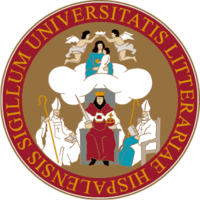University of Sevilla
| Universidad de Sevilla | |

Seal of the University of Seville
|
|
| Type | Public |
|---|---|
| Established | 1505 |
| Affiliation | PEGASUS |
| Students | 73,350 |
| Location | Seville, Andalucia, Spain |
| Website | Official Website |
The University of Seville (Universidad de Sevilla) is a university in Seville, Spain. Founded under the name of Colegio Santa María de Jesús in 1505, it has a present student body of over 65,000, and is one of the top-ranked universities in the country.
The University of Seville originally dates to the 15th century. Created by Archdeacon Maese Rodrigo Fernández de Santaella, it was originally called Colegio de Santa Maria de Jesus, and was confirmed as a practicing university in 1505 by the papal bull of Pope Julius II. Today, the University of Seville is known for research in technology and science.
In the middle of the 13th century, the Dominicans, in order to prepare missionaries for work among the Moors and Jews, organised schools for the teaching of Arabic, Hebrew, and Greek. To cooperate in this work and to enhance the prestige of Seville, Alfonso the Wise in 1254 established "general schools" (escuelas generales) of Arabic and Latin in Seville. Alexander IV recognized this foundation as a generale litterarum studium by the Papal Bull of 21 June 1260 and granted its members certain dispensations in the matter of residence. Later, the cathedral chapter established ecclesiastical studies in the College of San Miguel. Rodrigo Fernández de Santaella, archdeacon of the cathedral and commonly known as Maese Rodrigo, began the construction of a building for a university in 1472; in 1502 the Catholic Monarchs published the royal decree creating the university, and in 1505 Julius II granted the Bull of authorization; in 1509 the college of Maese Rodrigo was finally installed in its own building, under the name of Santa María de Jesús, but its courses were not opened until 1516. The Catholic Monarchs and the pope granted the power to confer degrees in logic, philosophy, theology, and canon and civil law. The colegio mayor de Maese Rodrigo and the university proper, although housed in the same building, never lost their separate identities, as is shown by the fact that, in the 18th century, the university was moved to the College of San Hermenegildo, while that of Maese Rodrigo remained independent, although languishing.
The influence of the University of Seville, from the ecclesiastical point of view, was considerable, though not equal to that of the Universities of Salamanca and of Alcalá. Renowned alumni include Sebastián Antonio de Cortés, Riquelme, Rioja, Luis Germán y Ribón, founder of the Horatian Academy, Juan Sánchez, professor of mathematics at San Telmo, Martín Alberto Carbajal, Cardinal Belluga, Cardinal Francisco Solís Folch, Marcelo Doye y Pelarte, Bernardo de Torrijos, Francisco Aguilar Ribón, the Abate Marchena, Alberto Lista, and many others who shone in the magistracy, or were distinguished ecclesiastics. The University of Seville had a great influence on the development of the fine arts in Spain. In its shadow the school of the famous master Juan de Mal Lara was founded, and intellects like those of Fernando de Herrera, Juan de Arguijo, and many others were developed, while literary and artistic clubs were formed, like that of Francisco Pacheco, which was a school for both painting and poetry. During the period of secularization and sequestration (1845–57) the University of Seville passed into the control of the State and received a new organization.
...
Wikipedia
